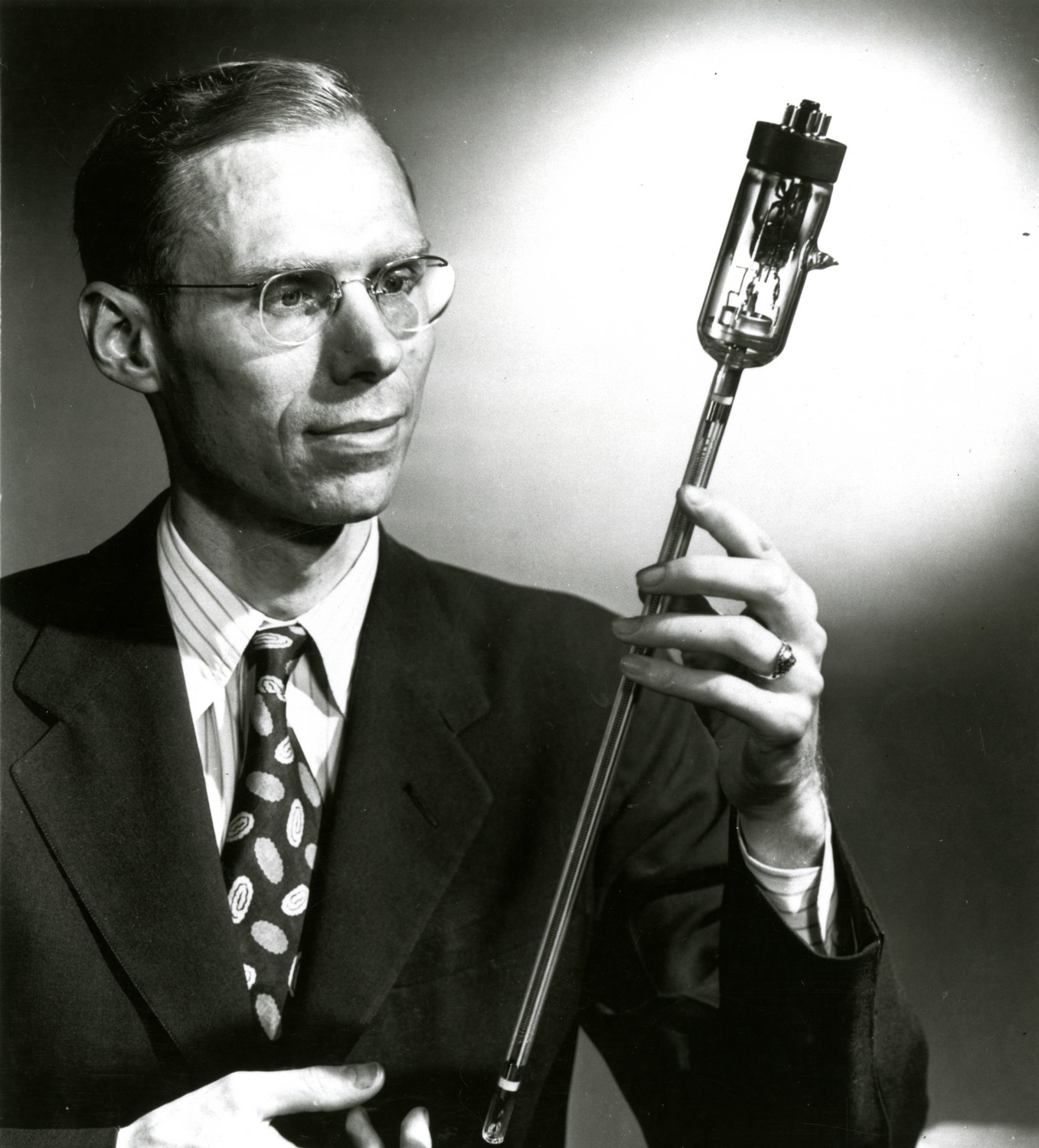John Pierce: Difference between revisions
No edit summary |
No edit summary |
||
| Line 1: | Line 1: | ||
== John Pierce: Biography<br> == | == John Pierce: Biography<br> == | ||
Born: 27 March 1910 <br>Died: 02 April 2002 | Born: 27 March 1910 <br>Died: 02 April 2002 | ||
| Line 25: | Line 23: | ||
== Further Reading == | == Further Reading == | ||
John Pierce. IEEE Oral History. [http://www.ieeeghn.org/wiki/index.php/John_Pierce_Oral_History_(Part_1) Part 1]. [http://www.ieeeghn.org/wiki/index.php/John_Pierce_Oral_History_(Part_2) Part 2]. [http://www.ieeeghn.org/wiki/index.php/John_Pierce_Oral_History_(Part_3) Part 3]. | John Pierce. IEEE Oral History. [http://www.ieeeghn.org/wiki/index.php/John_Pierce_Oral_History_(Part_1) Part 1]. [http://www.ieeeghn.org/wiki/index.php/John_Pierce_Oral_History_(Part_2) Part 2]. [http://www.ieeeghn.org/wiki/index.php/John_Pierce_Oral_History_(Part_3) Part 3]. | ||
<br>Pierce, John R. Interview by Harriett Lyle. Pasadena, California, April 16, 23, and 27, 1979. Oral History Project, California Institute of Technology Archives. Retrieved October 7, 2008 from the World Wide Web: [http://oralhistories.library.caltech.edu/98/ http://resolver.caltech.edu/CaltechOH:OH_Pierce_J]<br> | <br>Pierce, John R. Interview by Harriett Lyle. Pasadena, California, April 16, 23, and 27, 1979. Oral History Project, California Institute of Technology Archives. Retrieved October 7, 2008 from the World Wide Web: [http://oralhistories.library.caltech.edu/98/ http://resolver.caltech.edu/CaltechOH:OH_Pierce_J]<br> | ||
| Line 32: | Line 30: | ||
<br> | <br> | ||
[[Category:People_and_organizations]] [[Category:Scientists]] [[Category:Components,_circuits,_devices_&_systems|Category:Components,_circuits,_devices_&_systems]] [[Category:Electron_devices]] [[Category:Fields,_waves_&_electromagnetics|Category:Fields,_waves_&_electromagnetics]] [[Category:Magnetic_devices]] [[Category:Communications]] [[Category:Radio_communication]] [[Category:Satellite_communication]] | [[Category:People_and_organizations]] [[Category:Scientists]] [[Category:Components,_circuits,_devices_&_systems|Category:Components,_circuits,_devices_&_systems]] [[Category:Electron_devices]] [[Category:Fields,_waves_&_electromagnetics|Category:Fields,_waves_&_electromagnetics]] [[Category:Magnetic_devices]] [[Category:Communications]] [[Category:Radio_communication]] [[Category:Satellite_communication]] | ||
Revision as of 15:52, 23 January 2009
John Pierce: Biography
Born: 27 March 1910
Died: 02 April 2002

John R. Pierce holding a traveling-wave tube, which is used to amplify microwaves. Although he didn't invent it, his work led to great improvements to the device. Courtesy: AT&T.
John Robinson Pierce made many important contributions to microwave and communications technology during his long career at Bell Laboratories. He also made important contributions to the development of microwave electron tubes such as the “traveling-wave tube.” Pierce is also remembered for naming an amplifying device developed by some of his Bell Labs colleagues—the transistor. Finally, in the late 1950s, Pierce was an early and enthusiastic promoter of communications satellites and played a pivotal role in the development of two of the earliest, Echo I and Telstar.
Pierce was born on 27 March 1910 in Des Moines, Iowa, the son of a traveling salesman. Around 1930, his family moved to Long Beach, California, and then to Pasadena where Pierce was admitted to the California Institute of Technology. At Caltech, Pierce obtained both a B.S degree and a Ph.D. In 1936, just shortly after earning his doctorate, Pierce joined Bell Telephone Laboratories in New York City, where he worked on various problems concerned with electron-tube design. During World War II, this experience proved valuable when Bell Labs made the transition to microwave research in support of the U.S radar development effort. Pierce helped develop an improved type of “reflex klystron” tube, which was used in radar receivers.
In 1951 Austrian Rudolf Kompfner joined Bell Labs and began work on a new type of microwave amplifier called a traveling-wave tube. At the time, there were almost no practical electronic devices that could amplify microwaves in a broad range of frequencies. Pierce and Kompfner, working with other Bell Labs colleagues, developed a tube that amplified microwaves by making the waves slow down enough to be in step with an electron beam, which transferred its energy to the waves. The traveling-wave tube proved to be valuable for the construction of microwave communications relay stations both on the ground and later in orbiting communications satellites.
As early as 1954, Pierce advocated using satellites for communications between widely separated points on the ground. Following the Soviet Union’s launch of the first artificial satellite, Sputnik I, in 1957, the U.S government increased its own efforts to launch satellites. Pierce supported the idea of launching a 100-foot (30-meter) aluminum-covered balloon to serve as a passive reflector of microwaves from one ground station to the other. Named Echo I, this satellite was launched in 1960. In addition to relaying the words of President Eisenhower from the west coast to the east coast of the U.S, Echo I’s highly visible presence in the night sky advertised the fact to millions around the globe that the U.S could orbit satellites too.
With Pierce’s involvement, Bell Labs also developed an active communications satellite called Telstar I, which carried a miniature microwave relay station on board. Telstar enabled the first intercontinental television broadcasts to take place in 1962. Though Telstar was a technical success, changes in U.S government policy ended the Bell System’s further direct involvement in international satellite communications.
After resigning from Bell Labs in 1971, Pierce spent time teaching and doing research in communications and the acoustics of music at Caltech and Stanford University. He wrote several books on communications technology for popular audiences, as well as an autobiography and several science-fiction stories. The latter were published under the pseudonym J. J. Coupling. Pierce died in Sunnyvale, California on 2 April 2002.
Further Reading
John Pierce. IEEE Oral History. Part 1. Part 2. Part 3.
Pierce, John R. Interview by Harriett Lyle. Pasadena, California, April 16, 23, and 27, 1979. Oral History Project, California Institute of Technology Archives. Retrieved October 7, 2008 from the World Wide Web: http://resolver.caltech.edu/CaltechOH:OH_Pierce_J
Wolfgang Saxon, "John Robinson Pierce, 92, A Father of the Transistor," New York Times, Apr. 5, 2002;